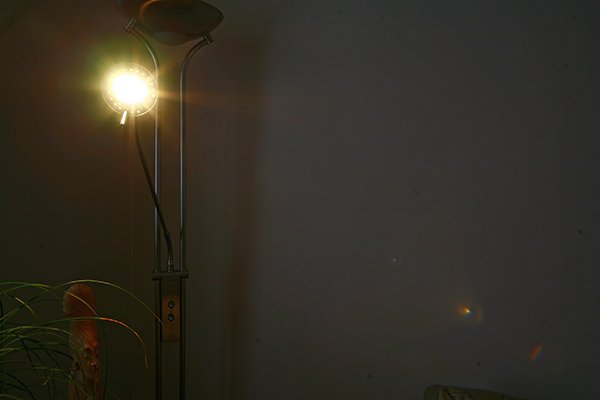Autofocus Converted Contax N Test: 17-35mm f2.8
Contax N 17-35mm f2.8 v Nikon AFS 17-35mm f2.8
Flare & Ghosting / Internal Reflection: 20mm
With all those elements and potentially aberration inducing glass surfaces, ghosting is typically troublesome for most zoom lenses. Though their intensity and visibility varies throughout the zoom range, the basic pattern is consistent. Here are both lenses at 20mm positioned with a bright light at short range raking across the front element.
 Contax 17-35mm / 20mm
Contax 17-35mm / 20mm
 Nikon 17-35mm / 20mm
Nikon 17-35mm / 20mm
The Nikon 17-35mm f2.8 can be seen showing similar ghosting at a longer focal length in the 24mm World Cup Final, but top marks to the Contax: where's the flare? With some coaxing, the tiniest of blobs were induced to materialise at 26mm, but in general, this lens is bulletproof with regard to handling bright lights: perfect for shooting directly into the sun, or twilight architectural photography. This is as bad as it gets . . .
 Contax 17-35mm / 26mm
Contax 17-35mm / 26mm
What about each lens' 'hoshi'? In other words, what kind of starburst is produced when a strong point light source is in the frame? Like bokeh once was, this is currently an overlooked aspect of lens performance, but one which makes a difference to the rendering of sunny skies, or in low-light photography where naked candles or street lamps appear in the frame. In some ways it is the flip side of bokeh, which attempts to describe, among other things, how a lens renders defocused points of light: here we're talking about the rendering of in-focus points of light.
Good hoshi might be defined as an attractive and well delineated starburst, between the spokes of which maximum detail is retained and the effects of flare are minimised. The boundaries of the light source should be well defined and symmetrical, not suffering from coma. Bad hoshi might be characterised by a wide halo of overexposure in which resolution and contrast are lost, combined with indistinct or ugly radial spokes of light. Light source boundaries would appear to be defocused, aberration prone and asymmetrical. Needless to say, the effect varies with aperture, exposure and precise placement of the focal plane. Here's the point illustrated by our two zooms, both at f5.6:
 Contax 17-35mm f2.8
Contax 17-35mm f2.8
 Nikon 17-35mm f2.8
Nikon 17-35mm f2.8
The Contax makes a better job of handling flare, retaining fine contrast all around the light source. It also draws the light source boundary more positively, but it has the same eight-pointed star at the Canon 24L, which some may not feel is as attractive as the 'twinkly' multi-pronged starburst rendered by the Nikon 17-35mm. As ever, the benchmark wide angle for truly stellar hoshi is the Contax 21mm Distagon f2.8!
For excellence is flare, ghosting and hoshi generally, the Contax 17-35mm is awarded a maximum of five points, with the Nikon awarded a bonus point for the way it decorates every light so prettily.





